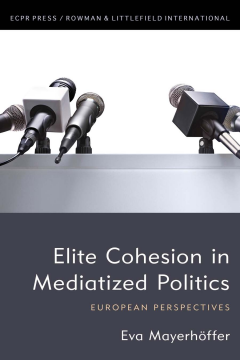
Additional Information
Book Details
Abstract
This book presents the first comprehensive analysis of the political communication elite– high-ranking journalists, editors, politicians and their communication advisors – that shapes the content and form of political messages, news, debate and decisions in modern democracies.
Based on an innovative combination of elite theory and political communication studies, the book develops an integrated and comprehensive approach to elite cohesion in political communication, focusing on the extent and patterns of attitudinal consonance among media and political elites.
Building on unique survey data from more than 1,500 high-ranking politicians and journalists in six European countries (Sweden, Denmark, Germany, Austria, France and Spain), the book provides unique insights into current reality of mediatized politics, and the key players shaping it.
Eva Mayerhöffer is Assistant Professor of Journalism at the Department of Communication and Arts, University of Roskilde. She holds a Ph.D. in Political Communication from Freie Universität Berlin. Her research focuses on elites in modern democracies, political communication, comparative media studies, journalism cultures and populism.
Mayerhöffer’s book is a complex study of the role orientations of media and political elites in six European countries. It analyzes the impact of the political context on the degrees of distinction, cohesion and collusion among the three groups, drawing on theoretical approaches of both communications and elite research. This important book develops an innovative approach for studying the relations among elite groups that are of central importance for our modern democracies.
Ursula Hoffmann-Lange, Professor of Political Science, University of Bamberg
Table of Contents
| Section Title | Page | Action | Price |
|---|---|---|---|
| Elite Cohesion in Mediatized Politics | Cover | ||
| Contents | v | ||
| List of Figures and Tables | ix | ||
| 1 Introduction | 1 | ||
| Rediscovering Elites | 1 | ||
| Why Elite Cohesion Matters | 3 | ||
| Between Elite Research and Political Communication Studies | 9 | ||
| A European Perspective | 11 | ||
| Outline of the Book | 14 | ||
| 2 Elites in Mediatized Politics | 17 | ||
| Towards Sectoral and Strategic Elites | 17 | ||
| Political Communication Elites | 22 | ||
| From Individual Elites to Elite Cohesion | 29 | ||
| Elite Cohesion in Political Communication Research | 33 | ||
| Summary: Key Challenges | 44 | ||
| 3 A Model of Elite Cohesion in Political Communication | 47 | ||
| Sources of Elite Cohesion: Values, Procedures, Epistemology | 48 | ||
| Guiding Principles of Cohesion: Ideology, Publicity, Pragmatism | 52 | ||
| Extent of Cohesion: Proximity and Indistinction | 56 | ||
| Patterns of Inter-Sectoral and Intra-Sectoral Cohesion | 59 | ||
| Consequences of Elite Cohesion | 66 | ||
| Contextual Conditions of Elite Cohesion | 72 | ||
| Summary: Elite Cohesion as Attitudinal Consonance | 80 | ||
| 4 Political Communication Elites in the European Context | 83 | ||
| Conditions for Elite Cohesion in the European Context | 83 | ||
| A Closer Look at the Context of Elite Cohesion: The Six Countries | 93 | ||
| Political Communication Elites: Operational Definition and Overall Sample | 109 | ||
| Collection of Survey Data and Final Sample | 116 | ||
| Summary: Studying Elite Cohesion in Six European Democracies | 117 | ||
| 5 Inter-Sectoral Cohesion in Political Communication | 119 | ||
| Measures of Inter-Sectoral Cohesion | 120 | ||
| Inter-Sectoral Cohesion from North to South | 121 | ||
| Principles, Patterns and Stances of Inter-Sectoral Elite Cohesion | 127 | ||
| Summary: Cohesion between Media and Political Elites | 139 | ||
| 6 Intra-Sectoral Cohesion of Media and Political Elites | 145 | ||
| Measures of Intra-Sectoral Cohesion | 146 | ||
| Attitudinal Congruence on the Sectoral Level | 147 | ||
| Patterns of Intra-Sectoral Cohesion | 153 | ||
| Role Specialization | 157 | ||
| Summary: Intra-Sectoral Cohesion | 164 | ||
| 7 Elite Cohesion as an Explanatory Factor | 167 | ||
| Functional, Ideological and Generational Separation | 168 | ||
| Elite Cohesion and Elite Interaction | 172 | ||
| Summary: The Significance of Sectoral Belief Systems | 178 | ||
| 8 Conclusion | 179 | ||
| Putting a New Elite on the Map | 179 | ||
| Modifications and Prospects for Future Research | 182 | ||
| Consequences of Elite Cohesion in European Democracies | 186 | ||
| Appendix | 193 | ||
| Notes | 201 | ||
| References | 205 | ||
| Index | 225 | ||
| About the Author | 229 |
